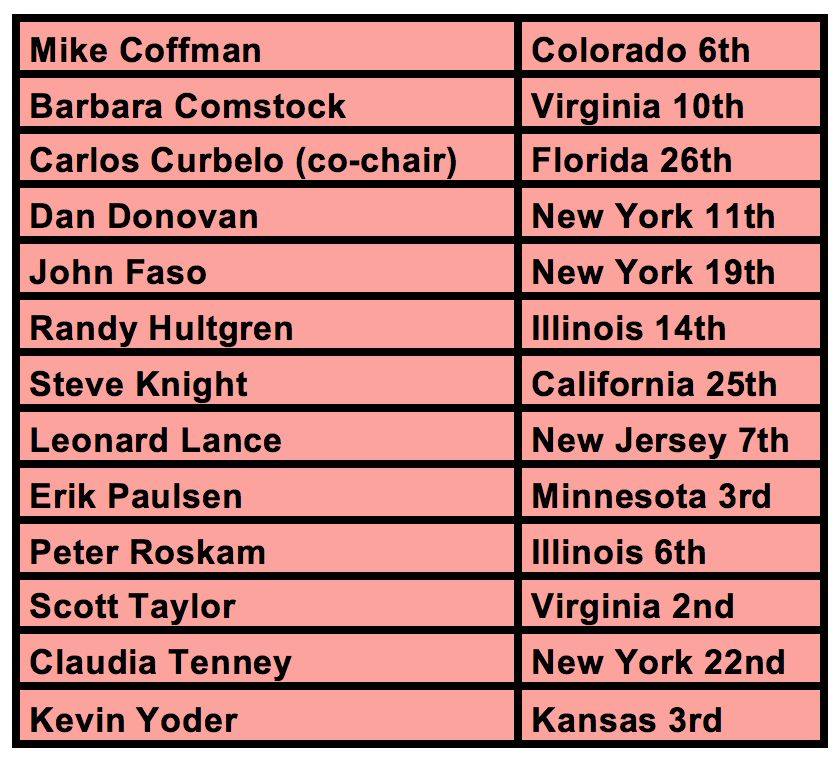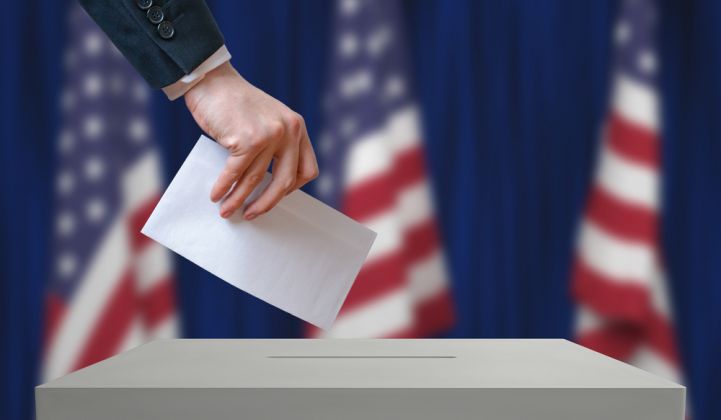A majority of Americans support expanding access to clean energy, and yet it never registers as a key voting issue.
This year’s midterm election was a little bit different, though. Healthcare, immigration and the economy were the top voter priorities in 2018, but in some specific races and on some specific ballots, clean energy was a central focus.
Here’s a rundown of the most important election results for the renewable energy agenda.
Climate Solutions Caucus gets slammed
The Republican members of the U.S. House of Representatives’ Climate Solutions Caucus were hard hit in Tuesday’s election. At least 13 of the 45 Republican Caucus members have lost their seats and five retiring members saw their seats claimed by Democrats. As of Wednesday afternoon, 20 Republican members had won back their seats, with two races (Mia Love in Utah and Tom MacArthur in New Jersey) still too close to call.
Most notably, Carlos Curbelo, the Republican co-chairman of the Climate Solutions Caucus, lost his seat in Florida. Curbelo sought to boost his green credentials in a left-leaning district by introducing a carbon tax earlier this year, but still failed to get the backing he needed.
Losing Republican Members of the House Climate Solutions Caucus

Updated: Wednesday, 5:00 p.m. EST
Some stakeholders fear damage to the Climate Solutions Caucus will erode all possibility of passing lasting, bipartisan climate legislation (as discussed in recent episodes of GTM’s Political Climate podcast). Conserve America, a politically conservative environmental group, blamed the Sierra Club and the League of Conservation Voters for slowing progress on climate change by opposing 27 of the 45 GOP Caucus members, including Curbelo.
Congratulations @SierraClub . You defeated the top climate action champion in Congress. A great man, moderate, whose absence will knock the knees out from climate progress.
— ConservAmerica (@ConservAmerica) November 7, 2018
The Climate Solutions Caucus will now have to restructure (if it survives), because it requires equal participation from both parties. But it’s unclear how big of an effect this will have on climate action in Congress. Republican Caucus members have voted against numerous pro-environment bills, despite their affiliation with the climate group.
Also, with Democrats now in control of the House, they can launch new efforts to address climate change and other environmental issues, which have taken a back seat in light of Republicans’ deregulatory agenda. House Democratic Leader Nancy Pelosi has already said she would resurrect the defunct select committee on climate change if her party took the House.
Democrats are also likely to push for modernizing energy infrastructure in order to deploy greater amounts of renewable energy, as outlined in the leadership’s “Better Deal” proposal. Steve Valk, communications director for the Citizens Climate Lobby, said he's optimistic a bipartisan climate bill will be introduced next session. He was also confident that the Climate Solutions Caucus would continue to grow.
“The Climate Solutions Caucus will go on, even though we’ve lost a number of Republicans, including Carlos Curbelo," Valk said in an interview.
Over the past two years the Caucus grew from six Republican members to 45 Republican members. “That’s because our volunteers were engaged with their members of Congress in their districts and asking them to join," he said. "We’ll continue to do that and we’re confident we’ll find more Republicans to replace the ones who aren’t returning.”
In other House race news, North Carolina Democrat Dan McCready, who ran on a clean energy platform in a conservative district, failed to win his race — but came close.
Notably, Democrat Sean Casten secured a seat in the House on Tuesday while running explicitly on a climate and clean energy platform in a tight Illinois swing district. Casten has a background in the clean energy industry and has called for using “competitive markets to encourage energy innovation.”
Nevada voters say yes to a 50% RPS, no to retail competition
Nevada voters passed Question 6 on Tuesday, which calls for the state to use 50 percent renewable energy by the year 2030. Supporters say Question 6 will generate hundreds of millions of dollars in economic activity and create thousands of new Nevada jobs.
“Clean energy is putting Nevadans to work, with more than 25,000 strong employed in 2017,” said Ray Fakhoury, state policy manager with the national business group Advanced Energy Economy, in statement. “By increasing the state’s renewable standard, Nevada has set itself up to continue reaping the economic benefits for years to come.”
Major corporations, including casinos and data centers, have recently been investing heavily in renewable energy in Nevada. With the passage of Question 6, Alli Gold Roberts, senior manager of state policy with Ceres, said the state is “poised to continue to attract corporate renewable energy investment.”
Corporate clean energy buyers invested heavily in a separate Nevada ballot measure, Question 3, which sought to deregulate Nevada’s retail electricity market, but the measure was ultimately unsuccessful. Question 3 was the subject of fierce debate. According to the Nevada Independent, it was backed by Sheldon Adelson’s Sands Corp. (Adelson also happens to be a major Republican donor) and the data company Switch, as well as many clean energy and environmental groups.
But there were also concerns about how Question 3 would affect electricity rates and clean energy adoption. The Natural Resources Defense Council, the Sierra Club, Southwest Energy Efficiency Project, and Western Resource Advocates came out against deregulating Nevada’s electricity market because of the disruption they said it would cause to the state's clean energy progress. NV Energy also opposed Question 3, and planned to spend $30 million on defeating it.
Nevada voters previously approved Question 3 on the 2016 ballot by a wide margin. But with Tuesday’s vote, the measure fails. In Nevada, proposals that would change the state constitution are required to pass in two successive even-numbered election years in order to be adopted.
Question 6, to boost the RPS to 50 percent, will now have to pass again in 2020 in order to become law. AEE’s Fakhoury said consumers could see benefits sooner than that. “Passing with wide support, the legislature and governor-elect should move forward in the upcoming legislative session to enact this landmark increase,” he said.
Arizona rejects 50% RPS
Arizona voters overwhelmingly rejected Proposition 127 on Tuesday, a constitutional amendment that would have required 50 percent of the state's electricity to come from renewable sources by 2030. It’s a significant victory for the state’s largest utility, Arizona Public Service (APS), which spent heavily to oppose the measure. California billionaire Tom Steyer's political group NextGen America funded efforts in support of the measure.
Proposition 127 was by far the most expensive ballot initiative in Arizona state history. Opponents said the measure would increase electric bills by forcing utilities to build new solar and wind plants, which would result in the early closure of coal plants and the state's lone nuclear plant. Supporters argued those claims were unfounded given that renewable energy resources are now competitive with fossil fuels, even when coupled with battery storage.
APS was particularly outspoken about losing the Palo Verde nuclear plant if the RPS measure passed. If that plant goes offline, the utility argued, greenhouse gas emissions in the state would rise.
While Proposition 127 has failed, Arizona regulators are still considering a proposal to increase Arizona’s RPS to 80 percent by 2050 and broaden it to also include nuclear power. APS generally supports that plan.
“We've said throughout this campaign there is a better way to create a clean-energy future for Arizona that is also affordable and reliable," said APS Chairman, President and CEO Don Brandt, in a Tuesday statement.
Now that the campaign is over, he said the utility wants to “continue the conversation with Arizonans about clean energy and identify specific opportunities for APS to build energy infrastructure that will position Arizona for the future.”
Washington state rejects a carbon price — again
Washington state has failed, once again, to pass a carbon tax. Initiative 1631, the Carbon Emissions Fee Measure, would have set a carbon fee starting at $15 per ton in 2020, rising to around $55 per ton in 2035, depending on inflation.
This is the second major election in a row in which Washington voters have rejected a ballot initiative that would put a price on carbon emissions. The first such ballot was proposed in 2016 and failed.
Tuesday’s loss may cast doubt on the broader narrative that states will lead on climate action in the absence of federal leadership, or it could signal that Americans simply aren’t ready to get behind a carbon tax. Alternatively, it could have all come down to spending. Supporters of Initiative 1631 spent at least $12 million to advance the measure, while opponents spent more than $25 million.
Colorado votes down a fracking ban
Colorado voters rejected a measure Tuesday that would have blocked new oil and gas drilling within 2,500 feet of homes, schools and other occupied areas.
Proposition 112 stemmed from complaints that fracking was encroaching on populated areas, creating health and safety concerns. An analysis showed that the measure would have blocked new oil and gas wells on 85 percent of nonfederal land in Colorado, which is America’s fifth-largest gas-producing and seventh-largest oil-producing state.
Florida voters reject offshore drilling — and e-cigarettes?
Offshore oil drilling and e-cigarette use in the workplace were both rejected by Florida voters on Tuesday, as part of the same — strange — ballot measure. The two seemingly unrelated issues were coupled on Florida’s Amendment 9, nicknamed the “clean air, clean water” amendment. The Constitution Revision Commission’s decision to approve the joint measure for the ballot earlier this year has been roundly criticized.
While voters agreed to ban oil and gas drilling off the coast of the Sunshine State, oil and gas companies say the ballot is redundant, given Florida already has statute in place that makes it illegal to drill within state-controlled waters. Environmentalists generally supported Amendment 9, but warned there remains a threat that the Trump administration will allow oil and gas drilling in federal waters just outside of Florida’s jurisdiction.
Californians keep the gas tax
No one really wants to pay more for fuel, and yet voters in California just chose to keep the state’s higher gas tax in place. California Republicans campaigned hard on the tax repeal, while Governor Jerry Brown warned such a move would cut off the funding source for much-needed road repairs.
Democrats passed the gas tax as part of SB 1, which also pledges that revenues will also go to bike and pedestrian paths, rail projects and toward the state parks and agriculture departments.
***
Join GTM at the upcoming Power & Renewables Summit! We'll cover how decarbonization, sector electrification and shifting regulatory developments will transform power markets over the next 10 to 20 years. We have already confirmed senior executives with FERC, Exelon, ERCOT, PJM, APS, Tesla, Dell, CPS Energy, NRG, CohnReznick, the Los Angeles Department of Water & Power and many more. Learn more here.




